light CHEVROLET CAMARO 1994 4.G Owners Manual
[x] Cancel search | Manufacturer: CHEVROLET, Model Year: 1994, Model line: CAMARO, Model: CHEVROLET CAMARO 1994 4.GPages: 292, PDF Size: 15.35 MB
Page 10 of 292
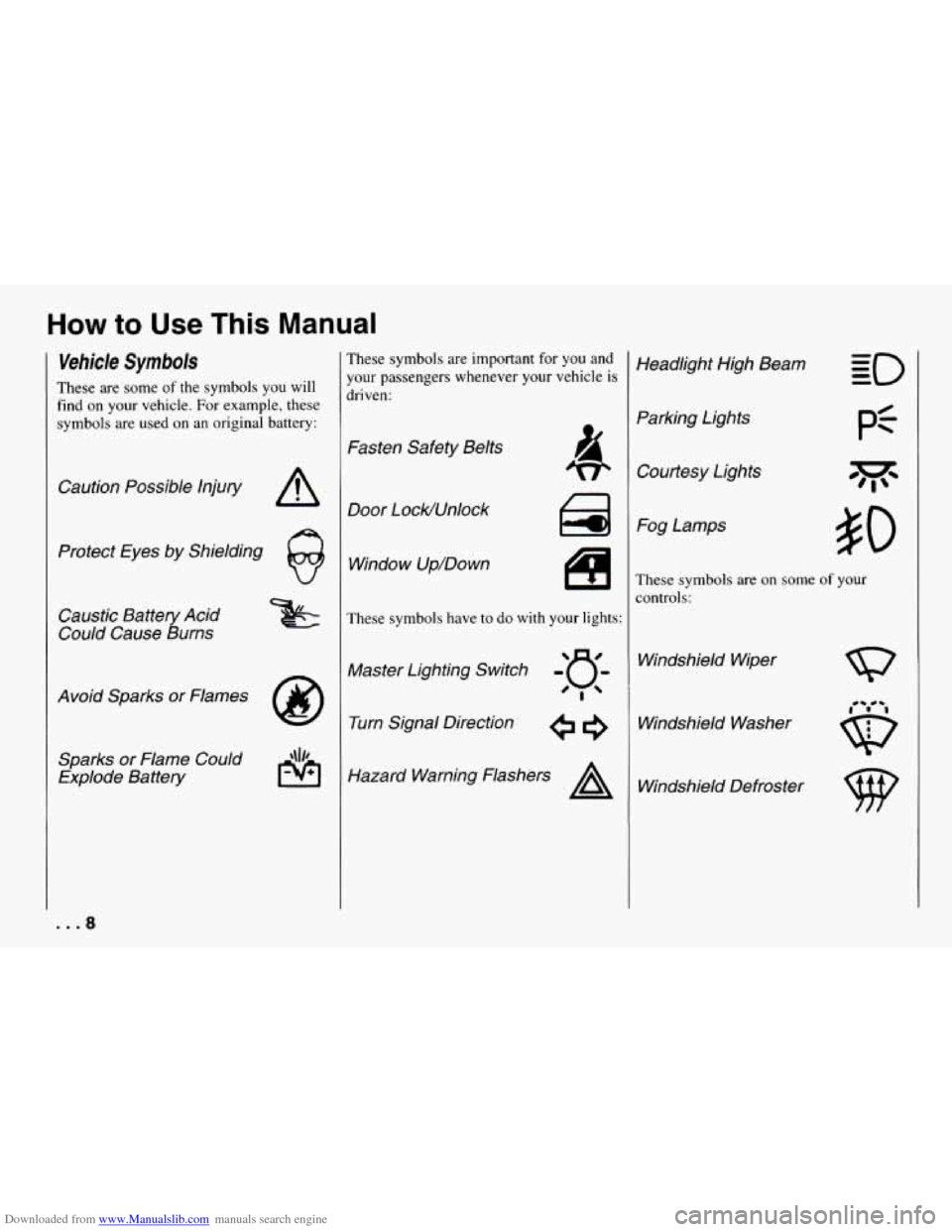
Downloaded from www.Manualslib.com manuals search engine How to Use This Manual
Vehicle Symbols
These are some of the symbols you will
find
on your vehicle. For example, these
symbols are used on an original battery:
Caution Possible Injury
A
Protect Eyes by Shielding
@
Caustic Battery Acid
Could Cause Burns
Avoid Sparks or Flames
8
Sparks or Flame could
Explode Battery
These symbols are important for you and
your passengers whenever your vehicle
is
driven:
Fasten Safety Belts
Door LocWUnlock
Window Up/Down
These symbols have to do with your lights:
Master Lighting Switch
Turn Signal Direction
Hazard Warning Flashers
A
Headlight Hlgh Beam
Parking Lights
Courtesy Lights
Fog Lamps
$0
These symbols are on some of your
Zontrols:
Windshield Wiper
Windshield Washer
Windshield Defroster
...e
Page 11 of 292
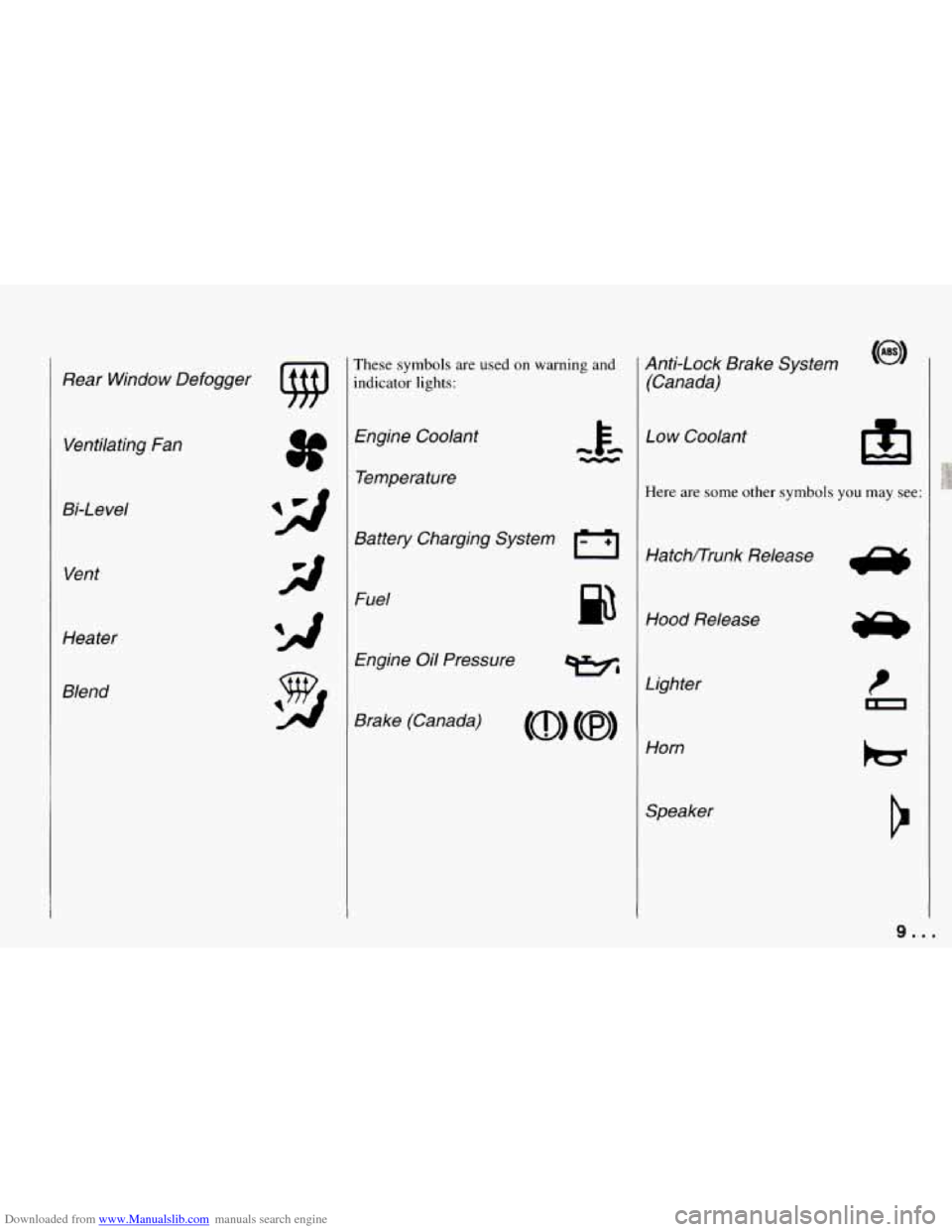
Downloaded from www.Manualslib.com manuals search engine Rear Window Defogger Ventilating Fan
Bi-Level Vent
Heater
Blend
These symbols are used on warning and
indicator lights:
Engine Coolant
Temperature
Battery Charging System
El
Fuel
Engine Oil Pressure
Brake (Canada) Anti-Lock Brake System
(Canada)
Low Coolant
m
Here are some other symbols you may see:
Hatchflrunk Release
Hood Release
Lighter Horn
B
k3
Speaker
9..
Page 13 of 292

Downloaded from www.Manualslib.com manuals search engine w a .
Here you’ll find information
about the seats in your
Chevrolet and
how to use
your safety belts properly
. You
can also learn about some
things you should
not do with
safety belts
.
Part 1
Seats & Restraint Systems
SeatsandSeatControls ............................................. 12
Safety Belts: They’re for Everyone .................................... 16
Why Safety Belts Work ............................................. 17
Here Are Questions Many People Ask about Safety Belts - and the Answers . . 19
Safety Belt Reminder Light .......................................... 20
How to Wear Safety Belts Properly .................................... 21
Children ......................................................... 34
Child Restraints
................................................... 35
LargerChildren
................................................... 42
Safety Belt Extender
............................................... 43
Checking Your Restraint Systems
..................................... 43
Replacing Safety Belts after a Crash
................................... 44
11 ...
Page 18 of 292

Downloaded from www.Manualslib.com manuals search engine Seats and Restraint Systems
Safety Belts: They’re
for Everyone
This part of the manual tells you how to
use safety belts properly. It also tells you
some things you should not do with safety
belts, And
it explains the Supplemental
Inflatable Restraint, or
“air bag” system.
:his figure lights up as a reminder to
buckle up. (See
“Safety Belt Reminder
Jght” in the Index.)
n many states and Canadian provinces,
he law says to wear safety belts. Here’s
vhy: Thev work. You
never know
if you’ll be in a crash. If
you do have a crash, you don’t know if it
will be a bad one.
A few crashes are mild, and some crashes
can be
so sieri~u~ that even buckled up a
person wouldn’t survive. But most
crashes are
in between. In many of them,
people
who buckle up can survive and
sometimes walk away. Without belts they
could have been badly hurt or killed.
After more than 25 years of safety belts in
vehicles, the facts are clear. In most
crashes buckling up does matter
... a lot!
. . .16
Page 22 of 292
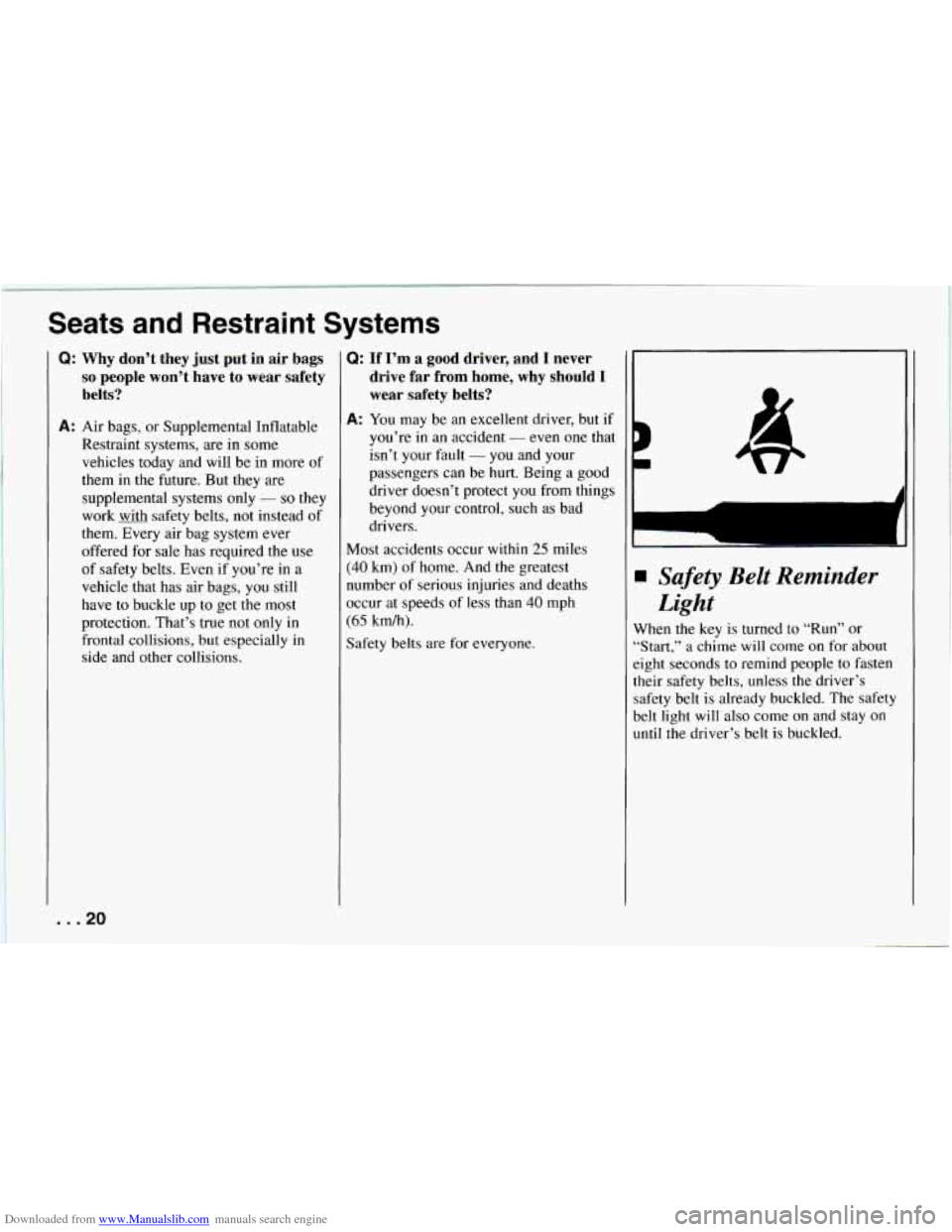
Downloaded from www.Manualslib.com manuals search engine Seats and Restraint Systems
Q: Why don’t they just put in air bags
so people won’t have to wear safety
belts?
A: Air bags, or Supplemental Inflatable
Restraint systems, are in some
vehicles today and will be in more of
them in the future. But they are
supplemental systems only
- so they
work
with safety belts, not instead of
them. Every air bag system ever
offered for sale has required the use
of safety belts. Even if you’re in
a
vehicle that has air bags, you still
have to buckle up
to get the most
protection. That’s true not only
in
frontal collisions, but especially in
side and other collisions.
Q: If I’m a good driver, and 1 never
drive far from home, why should
I
wear safety belts?
A: You may be an excellent driver, but if
you’re in an accident - even one that
isn’t your fault
- you and your
passengers can be hurt. Being
a good
driver doesn’t protect you from things
beyond your control, such as bad
drivers.
Most accidents occur within
25 miles
(40 km) of home. And the greatest
number
of serious injuries and deaths
occur at speeds
of less than 40 mph
(65 km/h).
Safety belts are for everyone.
Safety Belt Reminder
Light
When the key is turned to “Run” or
“Start,” a chime
will come on for about
eight seconds to remind people
to fasten
their safety belts, unless
the driver’s
safety belt is already buckled. The safety
belt light will also come
on and stay on
until the driver’s belt is buckled.
... 20
Page 28 of 292
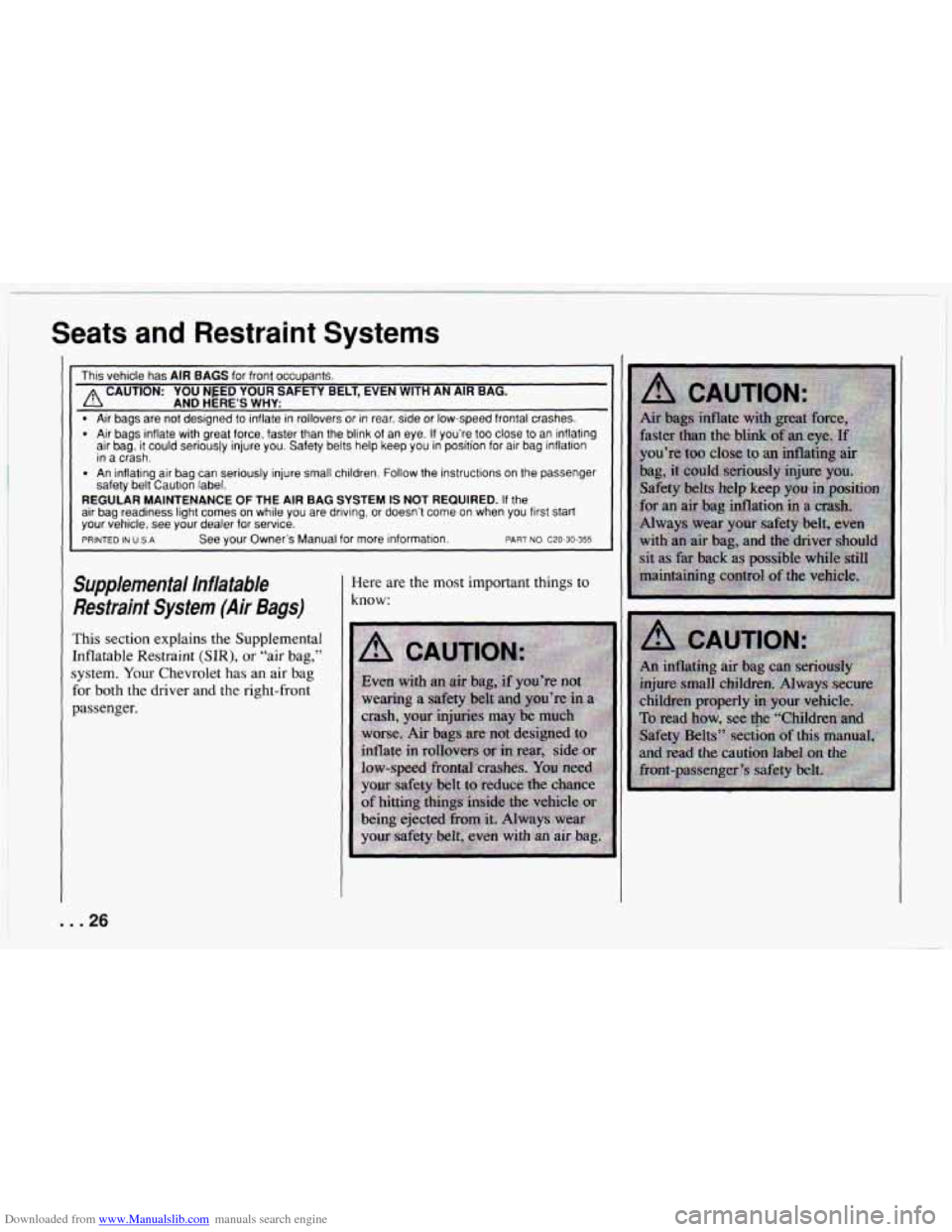
Downloaded from www.Manualslib.com manuals search engine ’ Seats and Restraint Systems
This vehicle has AIR BAGS for front occupants.
A CAUTION: YOU NEED YOUR SAFETY BELT, EVEN WITH AN AIR BAG.
AND HERE’S WHY:
Air bags are not designed to inflate in rollovers or in rear, side or low-speed frontal crashes.
Air bags inflate with great force, faster than the blink of an eye.
If you’re too close to an inflating
air bag, it could seriously injure you. Safety belts help keep\
you in position for air bag inflation
in a crash.
. An inflating air bag can seriously injure small children. Follow t\
he instructions on the passenger
safety belt Caution label.
REGULAR MAINTENANCE OF THE AIR BAG SYSTEM IS NOT REQUIRED. If the
air bag readiness light comes on while you are driving, or doesn’t come on when you first start
your vehicle, see your dealer for service.
PRINTED IN U.5.A See your Owner’s Manual for more information. PART NO. C20-30-355
Supplemental lnfhtable
Restraint System (Air Bags)
This section explains the Supplemental
Inflatable Restraint
(SIR), or “air bag,”
system.
Your Chevrolet has an air bag
for both the driver
and the right-front
passenger. Here
are the most important things to
know:
... 26
Page 29 of 292

Downloaded from www.Manualslib.com manuals search engine air bag, or, worse, it could cause inju-
ry. . .
E
ne
Y
k
SC ..
0
R
d
V
Y
n
SC
A
BAG
1
kir Bag Readiness Light
’here is an air bag readiness light on the
xtrument panel, which shows
“AIR
LAG” on it. The system checks for
lectrical malfunctions, and the light tells
ou if there is a problem.
‘ou will see this light flash for a few
econds when you turn your ignition
to
Run” or “Start.” Then the light should g(
ut, which means the system is ready.
:emember, if the air bag readiness light
oesn’t come on when you start your
ehicle, or stays on, or comes on when
ou are driving, your air bag system may
ot work properly. Have your vehicle
zrviced right away.
How the Air Bag System Works
Where is the air
bag?
The driver’s air bag is in the middle of the
steering wheel.
27 ...
Page 47 of 292
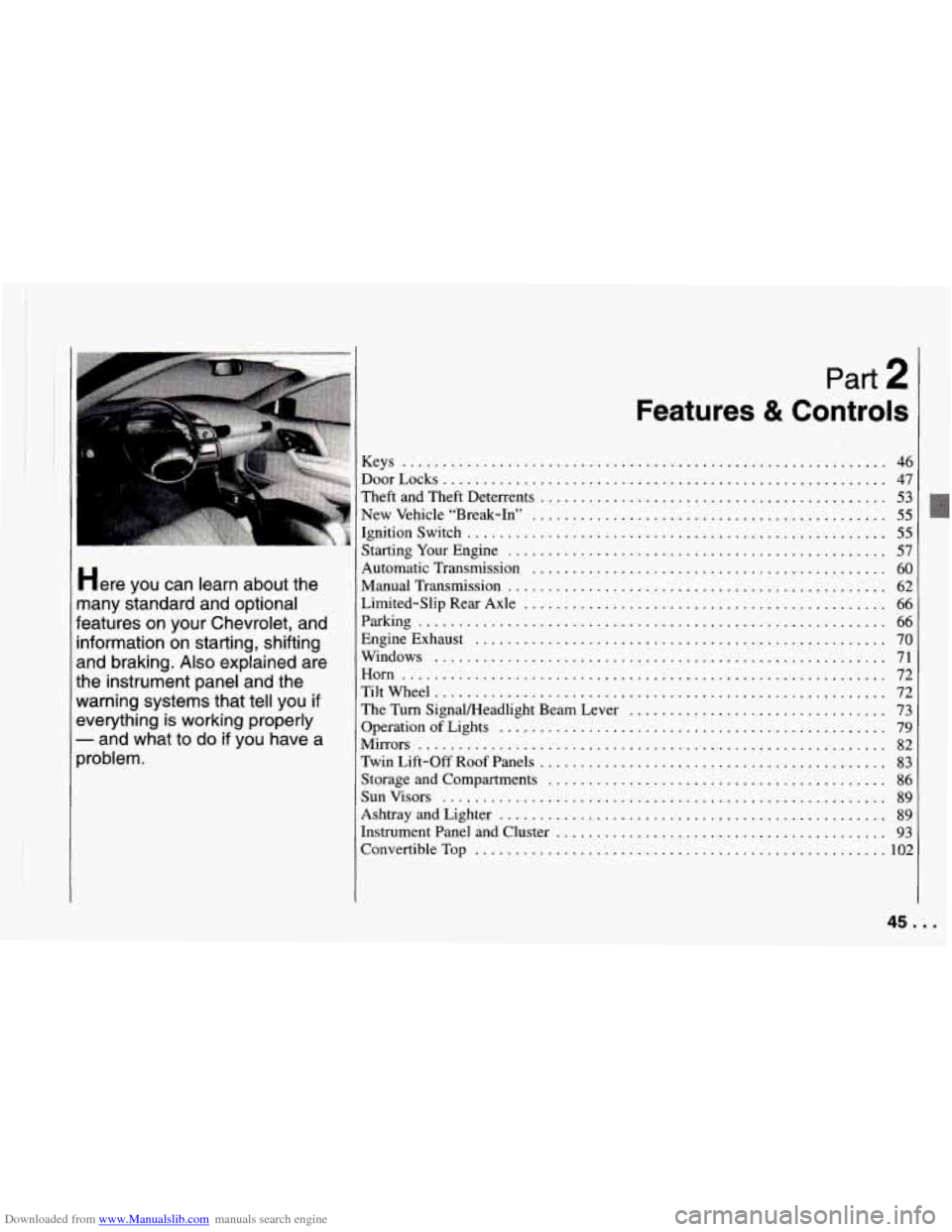
Downloaded from www.Manualslib.com manuals search engine Here you can learn about the
nany standard and optional
eatures on your Chevrolet. and
nformation
on starting. shifting
md braking
. Also explained are
he instrument panel and the
varning systems that tell you
if
tverything is working properly
- and what to do if you have a
)roblem .
.
... ........ Part 2
Features & Contro
Keys ............................................................
DoorLocks .......................................................
Theft and Theft Deterrents ...........................................
New Vehicle “Break-In” ............................................
Ignitionswitch ....................................................
StartingYourEngine ...............................................
Automatic Transmission ............................................
ManualTransmission ...............................................
Limited-Slip Rear Axle .............................................
Parking ..........................................................
EngineExhaust ...................................................
Windows ........................................................
Horn ............................................................
TiltWheel ........................................................
OperationofLights ................................................
Mirrors ..........................................................
Twin Lift-off Roof Panels ...........................................
Storage and Compartments ..........................................
Sunvisors .......................................................
Ashtray and Lighter ................................................
Instrument Panel and Cluster .........................................
ConvertibleTop ...................................................
The Turn Signameadlight Beam Lever ................................
S
46
47
53
55
55
57 60
62
66
66
70
71
72
72
73
79
82
83
86
89
89
93
102
45 ...
Page 51 of 292

Downloaded from www.Manualslib.com manuals search engine I9
Remote Lock Control (Option)
If your Chevrolet has this option, you can
lock and unlock your doors or unlock
your hatch from about
30 feet (9 m) using
the key chain transmitter supplied with
your vehicle.
Your Remote Lock Control operates on a
radio frequency subject to Federal
Communications Commission (FCC)
Rules.
This device complies with Part
15 of the
FCC Rules. Operation is subject to the
following two conditions:
(1) This device
may not cause harmful interference, and
(2) This device must accept any
interference received, including
interference that may cause undesired
operation. Should interference
to this system occur,
try this:
0 Check to determine if battery
replacement is necessary. See the
instructions on battery replacement.
0 Check the distance. You may be too
far from your vehicle. This product
has a maximum range.
0 Check the location. Other vehicles or
objects may be blocking the signal.
See your Chevrolet dealer or a
qualified technician for service.
Changes or modifications to this system
by other than an authorized service
facility could void authorization to use
this equipment.
Operation
The driver’s door will unlock
automatically when “UNLOCK’ is
pressed. If “UNLOCK” is pressed again
within five seconds, the passenger door
will also unlock. All doors will
lock when
“DOOR” is pressed. The hatch will
unlock when the opened trunk symbol is
pressed, but only when the ignition switch
is not
in “Run”, and the transmission is in
“P’ (Park) if you have an automatic
transmission. If you have a manual transmission, the
parking brake must be
set.
The system will
turn on the interior lights
for about
40 seconds, or until the ignition
switch is turned to “Run”, when you
unlock the doors or hatch. The interior
lights will come on for about two seconds
when you lock the doors.
Matching Transmitter(s) to Your
Vehicle
Each key chain transmitter is coded to
prevent another transmitter from
unlocking your vehicle. If a transmitter is
lost or stolen, a replacement can be
purchased through your dealer.
Remember to bring any remaining
transmitters with you when you
go to
your dealer. When the dealer matches the
replacement transmitter to your vehicle,
the remaining transmitters must also be
matched. Once the new transmitter is
coded, the lost transmitter will not unlock
your vehicle.
49. .
Page 55 of 292

Downloaded from www.Manualslib.com manuals search engine Theft
Vehicle theft is big business, especially in
some cities. Although your Chevrolet has
a number of theft-deterrent features, we
know that nothing we put on it can make
it impossible to steal. However, there
are
ways you can help.
Key in the ignition: If you walk away
from your vehicle with the keys inside,
it’s an easy target for joy riders or
professional thieves
- so don’t do it.
When you park your Chevrolet and open
the driver’s door, you’ll hear a tone
reminding you to remove your key from
the ignition and take it with
you. Always
do this. Your steering wheel will be
locked, and
so will your ignition. If you
have an automatic transmission, taking
your key out also locks your transmission.
And remember
to lock the doors.
Parking at Night: Park in a lighted spot,
close all windows and lock your vehicle.
Remember
to keep your valuables out of
sight. Put them in a storage area, or take
them with you.
Parking Lots: If you park in a lot where
Someone will be watching your vehicle,
it’s best to lock it up and take your keys.
But what if you have to leave your
ignition key? What if you have to leave
something valuable in your vehicle?
0 Put your valuables in a storage area,
like your glove box.
0 Lock the glove box.
0 Lock all the doors except the driver’s.
Then take the door key with you.
PASS-Key@ZZ
Your vehicle is equipped with the
PASS-Key@II (Personalized Automotive
Security System) theft-deterrent system.
PASS-Key@II is a passive theft-deterrent
system. This means you don’t have
to do
anything different to arm or disarm the
system. It works when you insert
or
remove the key from the ignition.
PASS-Key@II uses a resistor pellet in
the ignition key that matches a decoder
in your vehicle.
53.